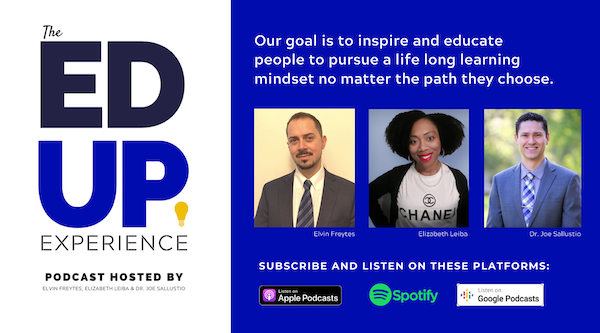The Age of Education as a Benefit Package: Marketing Experiential Pathways for Learners to the Workforce

Higher education has since a steady decline in enrollments over the past decade, and it doesn’t seem to be leveling out anytime soon. With an enrollment crash on the horizon, what higher ed needs to be looking at is experiential learning and affordable options to help adult learners get into the workforce quickly and efficiently. In this interview, Elvin Freytes and Joe Sallustio from EdUp Experience speak to Brandon Busteed about the great enrollment decline, how to market experiential learning, and the importance of creating pathways from education to employers.
EdUp Experience: In your keynote presentation at the 2019 AMA conference, you spoke about the great enrollment decline—could you explain more about what that is and why we should be aware of this pending decline?
Brandon Busteed (BB): I wouldn’t be in higher education if I didn’t believe in its current value and long-term viability. But there are a ton of headwinds in front of higher ed right now. We’ve created part of this ourselves as an industry. The rising cost issue is something that Americans are very concerned with, and although they still value higher education, their views of it have shifted pretty dramatically in the last ten years. This is based on rising costs, increasing student loan debt, questions about the work readiness of college graduates—which is one of the biggest concerns.
On top of that, there’s this very obvious population age demographic trough that we’re running when we reach 2025 and 2030. This is tomorrow in higher ed time, and we’re going to see a decline in the college-going population of traditional-age students in the United States by at least 15% across the board. Some regions may vary slightly from others, but when you think about it, a lot of colleges would go out of business if they had two or three years of consecutive drops in enrollment. Yes, there is some reason to panic since a lot of institutions aren’t moving fast enough. A lot of people have heard about this drop.
We’re certainly headed into even more turbulent times in higher ed, but there’s a lot of opportunity in the midst of that disruption and upheaval. There’s a challenge there for higher ed to think about ways to provide a different value proposition in addition to the one it does now. Frankly, to serve more students than it does today.
EdUp Experience: How do you think colleges and universities are reacting to that decline—is there great recognition around it?
BB: There’s a range as you might imagine. I’m certainly working and engaging with leaders of institutions because that’s the key factor in all this. It’s not like smaller institutions are moving faster than bigger ones or public versus private. There are dynamic leaders at the head of certain colleges and universities who are aligned with their senior leadership team, their board of trustees and who are moving fast and into some very exciting areas.
That said, they’re small numbers. The higher education market is aware of these challenges but isn’t moving fast enough—or if it is moving fast, it’s not with as much scale. We love to do pilot tests and try things out, but we’re in a place now where you have to pick a path and go, otherwise the delay will bring additional challenges. Shared governance has been one of higher ed’s strengths, but it’s also bogging down decision-making. We need to make big moves in a lot of these cases.
EdUp Experience: What are some of the very practical decisions and implementations that institution leaders are putting together to get ahead of the curve?
BB: Enrollment management is an area of opportunity. In that, experiential marketing is becoming one of the major forces of enrollment management. When the marketplace competing for 18-year-olds starts to contract, it only ramps up competition. That’s where you, as an institution, have to figure out how to get ahead of that.
It’s not just about targeting your traditional marketing as it’s been to try and make an impression on a prospective student while they’re in middle school or high school. The separate is going to go further upstream, and it’s going to be in the form of experiential marketing. Whether that’s actually coming to campus and being part of an immersion experience, beyond just your simple campus tour.
An institution I love is Lynn University because every student who comes on a tour will meet with a faculty member and a student from the general area that prospective student is from. It’s a labor- intensive program, but it’s fantastic.
In the world that I’m operating in now, we’re launching with a number of universities what we call pre-lum programs as in pre-alumni. The idea being that we’re going to take high-quality immersion courses that feature one of the star faculty from the institution and market towards high school students. The idea that students in high school or middle school can take those courses during the academic year or over the summer. The point is that there a lot of different forms of this experiential marketing that campuses can pursue, but it’s going to be beyond the pamphlet in the mail.
EdUp Experience: Do you think experiential marketing would work for adult learners knowing that they have busy lifestylesand responsibilities–what type of marketing strategies do you see for that type of market?
BB: It’s going to be a little bit different, but the same overall strategy applies. The pivots that folks like edX and Coursera have made in many ways, are now a wide part of the funnel for adult online degree programs. Somebody comes in, takes a short non-credit course but then become interested in the field. Perhaps they then see that there’s a certificate program offered that could interest them.
That’s where you see examples of micro-masters popping up. We’re seeing a market of people taking smaller bite-sized chunks of education because it’s just in time on a topic they want to learn about. In other cases, it’s helping create that beacon that draws them into interest in a longer, degree-based program.
The biggest driver for what’s going to happen in both the adult and traditional student markets is involving the employer. Right now, most people go to college to get a job, but we might see this major shift where people get a job to go to college. This is the age of education as a benefits movement. It’s an increasingly compelling value proposition not only for working adults but students coming out of high school. They want a degree but not the debt, so they’ll look to an employer who’s willing to help them get that education.
In this case, online is the assumed choice for most of them, but employers are still a factor in this. If you’re working for a company who says you could have a 30% pay increase if you had a specific degree or certificate, and they make it available to the employee, it becomes a huge motivational drive for that person. This will become a pretty common phenomenon.
EdUp Experience: Do you think parents are looking for educational alternatives for their kids so that both the parents and the kids aren’t stuck with the same student debt the parents are faced with?
BB: That’s definitely a big driver behind it, and there are always concerns around student loan debt. Half of graduates in the last five years have started paying only the interest on those loans. Another problem is socioeconomic status. Some people can afford college, but others can’t even get financial aid or even know how to start the college search process because no one in their family attended college. Ironically, there’s a lot of financial aid available but you need to know how to navigate the system, which is a whole other problem. The marketplace is very open to alternative pathways of getting a college degree. They still value the degree, but they are wide open in terms of how to accomplish it, especially if it can be done faster, cheaper and more effectively than through the traditional mode.
That “more effectively” point is the one that I was most intrigued by, which is this go pro early model wherein you’re working and learning at the same time. If you go back 60 years and look at the U.S. data, 18- to 25-year-olds were the least working generation because they were in school. We devalued work. Now, there’s an appetite for work. You can connect learning with what you’re doing at work—that’s a home run.
EdUp Experience: What are some of the best models that you see currently working for folks who want to finance their education?
BB: The United States has tried to address financial aid or the college cost issue by adding more aid on top of what exists–whether that’s scholarships or federal-level support. What we haven’t done is focus on reducing the cost of higher education. If costs increase, then it isn’t sustainable. We can throw as much aid as we want on it, which we kind of have, but if the costs never go down, we have some problems. That’s the area where there’s the most promise. In terms of financial aid, we haven’t really thought about the biggest lever we can pull, which is to reduce the cost.
EdUp Experience: Do you think there will be a college that will slash their prices to better align with the competitive market or will everything fall to the same pattern?
BB: It’s hard to predict anything, especially timing. There’s no doubt that we’re reaching a breaking point. We may have already reached it in terms of the average person’s ability to afford higher ed. That’s a driver of lower enrollments in and of itself. There are institutions out there with very affordable tuition rates. So, there are many routes through U.S. higher education that cost much less than others. It’s been ten years of declining higher ed enrollments, major declines in the public perceptions of higher ed. Those perceptions then translate into real action, with someone deciding to enroll or not.
On top of that, there’s no real evidence to suggest that more expensive colleges are of higher quality—most judgement is made through the lens of alumni ratings of personal experiences. Expensive institutions are worth it through from a graduate’s point of view, but there are also inexpensive institutions that are of as good quality. It’s not about the price tag, but about whether or not they’re delivering a high-quality experience and there’s evidence to suggest you can do that at a more affordable institution.
There’s no doubt that a winning playbook for institutions would resemble the one used by Purdue University. We play a lot of games with discount rates and things like that. You’re probably going to see more transparency in institutions saying, “Here’s the price tag” rather than “Here’s the price, and here’s the discount”. There’s this formula that goes in the middle, but there’s no doubt that its reduction in tuition–or a move like Purdue where they freeze tuition for a prolonged period of time. Those moves are actually going to become more popular because you’re going to see schools like Purdue not just survive through those moves but thrive through them. A smart observer would want to put their institution on a similar path. They’ll have to address it differently, but that’ll be a more popular thing to do.
If you look at U.S. higher education from a global perspective, an international student can go anywhere. We’re less competitive now than we’ve ever been because our price tags are so out of whack. A student could go to Imperial College of London (the ninth ranked university in the world) for less than a third of the cost of Duke University, which is ranked 17th in the world. There’s really no competition there anymore.
EdUp Experience: What legacy do you want to leave behind in higher ed?
BB: If I were to kind of give a succinct answer, I’d say it’s to ensure that we get higher ed to a place where it is always consumer-centric. The word consumer is going to become a non-starter in higher ed. It’s not a popular term, but I am thinking about students when I say consumer-centric. I’m also thinking about employers and democracy quite frankly. We’ve lost our way at an aggregate level and the consumer or customer centricity in higher education.
Right now, that happens to be the big concern of work-readiness of college graduates, so that’s a big theme. My work involves thinking about how college really can become an amazing engine, not just for creating lifelong learners but really making a meaningful driver of career well-being and career success. The whole thing revolves around building a more customer-centric institution of higher education.
EdUp Experience: What do you see is the future of education?
BB: It’s a merger of education and work. What I mean by that is not a technical merger or a financial merger, but from a K-12 level through higher ed into the workplace. We’re evolving fast toward a world in which it will be impossible to succeed at any job without constantly learning. Up skilling, re-skilling, re-tooling, whatever you might want to do.
To get the most out of school and education, we can maximize that by helping students at every level and every age understand how they apply that learning, how that learning is relevant to them, and how that learning propels them and their families forward economically.
Some may say that higher education is not about training people to get jobs. I have very different view about jobs and career importance. That is, that if you look at people’s well-being all over the globe, what does that look like more than anything else? The answer is a good job. The world believes that a good job helps them have a family, to be safe and healthy and secure. They see all of those other things accomplished through having a good job. The great global dream is a good job.
If education isn’t relevant to work preparation for a job, it’s becomes just about paycheck, when most want a job with purpose. If we think about a job and career as purpose, that’s where I hope more people get on board with this idea that the future of education is essentially a point when we won’t be able to tell the difference between education and work because those are essentially one and the same.
This interview was edited for length and clarity.
Disclaimer: Embedded links in articles don’t represent author endorsement, but aim to provide readers with additional context and service.
Listen to the full interview here.
Author Perspective: Administrator




